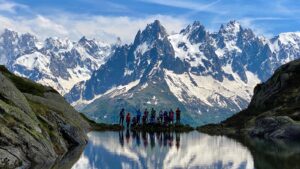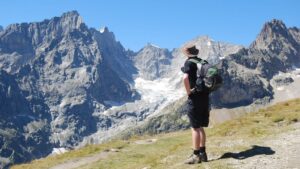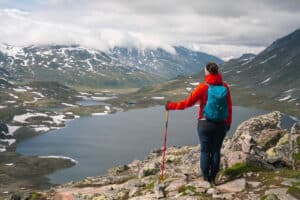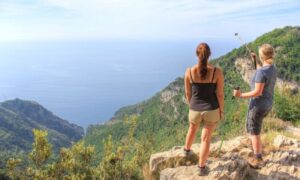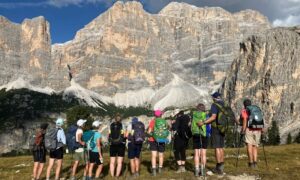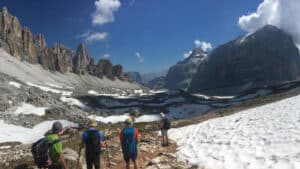Choose your trek
Select your trek and check availability, either by phoning us or sending an on-line enquiry.

This new trek links the mountains in the far west of Austria and the little-visited and slightly mysterious country of Liechtenstein. The one-way trip begins in Stuben, heading west along the famous Via Alpina red route which is a long-distance trek linking paths from Slovenia all the way to France. We then head south into Liechtenstein with high ridges and views of snowy mountains in the distance.
The scenery is Alpine meadows, rocky passes, valleys cut by rivers, and pretty villages dotted along the trail. You will see the mighty Rhine, towns with old palaces and fairytale-like turrets. We spend 6 nights in hotels, 1 in a guesthouse and 3 in mountain refuges to soak up the ambience. Luggage is transferred between accommodations when not staying in refuges.

Challenging.
Traditional Austrian fare served at hotels and refuges
Comfortable hotels, guesthouse and simple refuges
Experienced International Mountain Leader
Minimum 6 / Maximum 14 people
All treks will run with our minimum group size
Follow the Via Alpina from Austria into Liechtenstein.
Meet at Zurich International Airport at 13:00 hrs (1 pm). We will meet in Terminal 1 on Level 0, which is the arrivals area for domestic flights within Switzerland and the Schengen area.
Please note that Zurich airport is vast and it can take a bit of time to get from one side to the other. You may fly into Terminal 2 and have to transfer across.
We will then transfer you by road to our hotel in Stuben.
After breakfast, we take a short bus ride to Lech, famous for Princess Diana and its upmarket skiing. We walk west out of town, following the picturesque Lech River through meadows. Eventually, we cross the river and head uphill to the impressive Goppinger Hutte, which has been continually in use since 1913. The hut is located on the Gamsboden plateau, a high bowl surrounded by Alpine peaks that separate the Lech Valley from the Walser Valley.
After an early breakfast, we will continue to cross the plateau, threading between limestone peaks and dropping north into the Walser Valley. The Walser Valley gets its name from the Walser people who colonised the area in the 13th century after moving from Valais in Switzerland. The area is picturesque and has a typical mid-mountain charm.
The Via Alpina route here is locally known as the Walser trail. We follow the course of the Lutz stream gradually downhill over meadows and through mixed mountain forests and flood-plain woods, which are still preserved in their natural condition.
We continue west, passing through a variety of woodland, pastures, and small villages. As we approach the town of Feldkirch, our route is squeezed between the river and rock walls, which are used by local rock climbers. Feldkirch is the westernmost town in Austria and boasts the best-preserved medieval townscape in the province of Vorarlberg. Our hotel is situated in a pedestrianised street on the edge of the old quarter.
Feldkirch is a pretty medieval town with well-preserved buildings and churches. It is a nice place to wander around, take a coffee in one of the side streets, or visit one of the galleries or museums.
The Tourist Office is very helpful, and there are buses that can take you in 45 minutes to Vaduz, the capital of Liechtenstein. There are also trains to Bregenz, located on Lake Constance.
Today we head south alongside the border with Liechtenstein.
We continue on the Via Alpina, also known as the Panorama Trail, which winds through amazing rocky terrain using steps and bridges.
Using a local bus, we regain the path where we left it yesterday.
Our final day's trek starts with an ascent of Naafkopf, at 2,570m. It’s the third-highest peak in Liechtenstein and shares its peak with both Austria and Switzerland. We will return to the refuge for a short break before continuing on the trail. We ascend Augustenberg at 2,365m, which is the highest mountain wholly within Liechtenstein. Eventually, we drop down towards the summit of Spitz and then finish the Panorama Trail above Malbun. We descend into town for our last night’s stay and a celebratory meal together.
After breakfast we transfer to Zurich International Airport.
This map is for illustrative purposes only.
All hiking is led by a qualified International Mountain Leader with extensive experience in the Alps. They will ensure your safety and enjoyment throughout the trip.
Regular training in the hills with your fully loaded daypack in the months prior to your trip is the best preparation. It is a challenging, multi-day trek and you need to be confident of your fitness to enjoy it.
Our clients are a nice mix of solo travellers, couples and friends. Most are between 40-70 years old, though we do have a few younger members.
If you have any questions about whether this trek is right for you, please contact us. We have years of experience trekking in the Alps and can help you decide.
The Austria and Liechtenstein traverse is a good mountain trek with some long hiking days and significant elevation changes. It requires good fitness and previous trekking experience is preferable.
Days are typically 6-8 hours on the trail, with daily ascents/descents of 800-2000m. You'll cover 12-21km per day, hiking at altitudes between 1000-2600m. The terrain is varied, ranging from well-travelled trails to rocky paths and the occasional exposed tree route.
While you only need to carry a daypack, there are 3 nights (days 3, 7 & 9) where we stay at mountain refuges in mixed-sex dormitories with shared bathrooms. You'll need to carry your overnight essentials: spare underwear, socks, T-shirt and a few toiletries.
The 11-day Austria & Liechtenstein Traverse price includes:
In addition to the trek cost, you should budget for the following extra expenses:
Credit cards are widely accepted, but we recommend carrying about €100-150 in cash for small purchases. The two refuges in the Liechtenstein only take cash. ATMs are available in Feldkirch but not in the small villages or on the trail.
We strongly recommend being prepared and bring broken-in boots.
For the mountain refuge nights without access to your main luggage, you'll need to carry your backpack with essentials like clean base layers, spare socks and basic toiletries. The refuges provide blankets and pillows, but you need to bring your own sheet-sleeping bag.
Hotels (7 nights)
Mountain Refuges (3 nights)
The mountain inns or refuges offer more basic lodging in spectacular high-mountain settings.
All transport during the Austria & Liechtenstein tour is included. This comprises:
Arrival and departure transfers
Local transfers
The transfer to Stuben takes 2-2.5 hours.
If you miss the airport transfer you should call us for information on how to get to the start of the trek: any costs incurred will be your responsibility. Please note that it is 2-2.5 hours by road to Stuben: a taxi will be expensive. You could transfer by train and bus to Stuben with a number of changes en-route. You are welcome to arrange your own transport to the hotel in Stuben at your own expense.
Your main luggage is transferred between hotels.
Every morning, you'll leave your main bag at the hotel reception with a luggage tag we provide you. The bags are picked up and transferred in a van to your next accommodation.
For the nights when you stay at the mountain refuges (night 2, 7, 9) you will not have access to your main luggage and so you'll just need to pack a few overnight essentials (toiletries, change of underwear, socks and T shirt and a sheet sleeping bag for the refuges).
Luggage is limited to 1 bag per person, with a maximum weight of 18kg. Please bring soft luggage like sports bags or backpacks. Bags should be clearly labeled with your name.
We highly recommend you do not pack any valuables (laptops, money etc) in your transferred luggage in the unlikely event of damage or theft. Luggage is generally transferred to each hotel's reception area. Keep your passport, wallet, phone, camera, and any medications with you in your daypack. Your main bag will not be accessible during the day.
The group transfer for this trek is from Zurich International Airport (ZRH), where you'll meet your guide and fellow hikers. We will meet at 13:00hrs (1pm) in Terminal 1 on Level 0, which is the arrivals area for domestic flights within Switzerland and the Schengen area. Please note that Zurich airport is vast and it can take a bit of time to get from one side to the other. You may fly into Terminal 2 and have to transfer across.
It's about a 2-2.5 hour drive to Stuben.
If you miss the group transfer, you'll need to make your own way to Stuben at your expense.
Flying into Zurich is relatively straightforward from many European and international hubs.
Departure: The group transfer drops off at Zurich International Airport by 12:00hrs (midday) on Day 11. If you need to arrive earlier for a flight, you'll need to book a private transfer (we can assist). Please don't book flights departing Zurich before 14:30hrs (2:30pm) to ensure adequate time for check-in.
It is your responsibility to check your specific passport, visa and entry requirements and ensure you have the necessary documents for all countries on the trek. Regulations can change, so review the rules before you travel.
You should bring a copy of your insurance policy with emergency contact numbers. Leave a copy with someone back home.
The summer hiking season in the this Alpine region runs from mid-June through late-September. During this time, weather conditions are generally favourable for trekking, with warm and sometimes hot days. However, as with all mountain ranges it can rain - either as frontal weather or as thunderstorms after a hot day - and you should come prepared for this.
Temperature: Expect daytime highs of 20-25°C (68-77°F) in the valleys and 10-15°C (50-59°F) at higher elevations. Night temperatures dip down to 10-15°C (50-59°F), feeling colder at altitude.
It's essential to come prepared for a wide range of mountain weather, with layers that can be adjusted throughout the day.
Your guide will check the forecast daily and adjust the hiking plan if needed for safety and enjoyment.
Select your trek and check availability, either by phoning us or sending an on-line enquiry.
Complete an on-line booking form and pay a deposit of 20% of the tour.
Payments are in British Pounds (GBP). You can pay by bank transfer, credit or debit card.
Once the payment has been received we will send you an e-mail confirmation.
We run our Austria & Liechtenstein trek during the optimal summer hiking months. Upcoming departure dates for 2024 include:
A scenic, challenging trek with steep sections and tough terrain. Excellent accommodation, food, and guiding by Pete. Despite slow group members, the stunning scenery made it worthwhile.
TMB was an awesome hike! Salamanders did an excellent job at organizing hotels, all very comfortables, bagage transfer, and the hiking notes provided useful tips throughout the journey.
Well-organised and caring attitude. Rooms and hotels were of a high standard. The suggestions for activities were most helpful.
Highly recommended.
Very recommended. Perfect organised. Our guide was great (Luke Emms).You don't have to worry about the quality of the service or choice of accommodation at all.
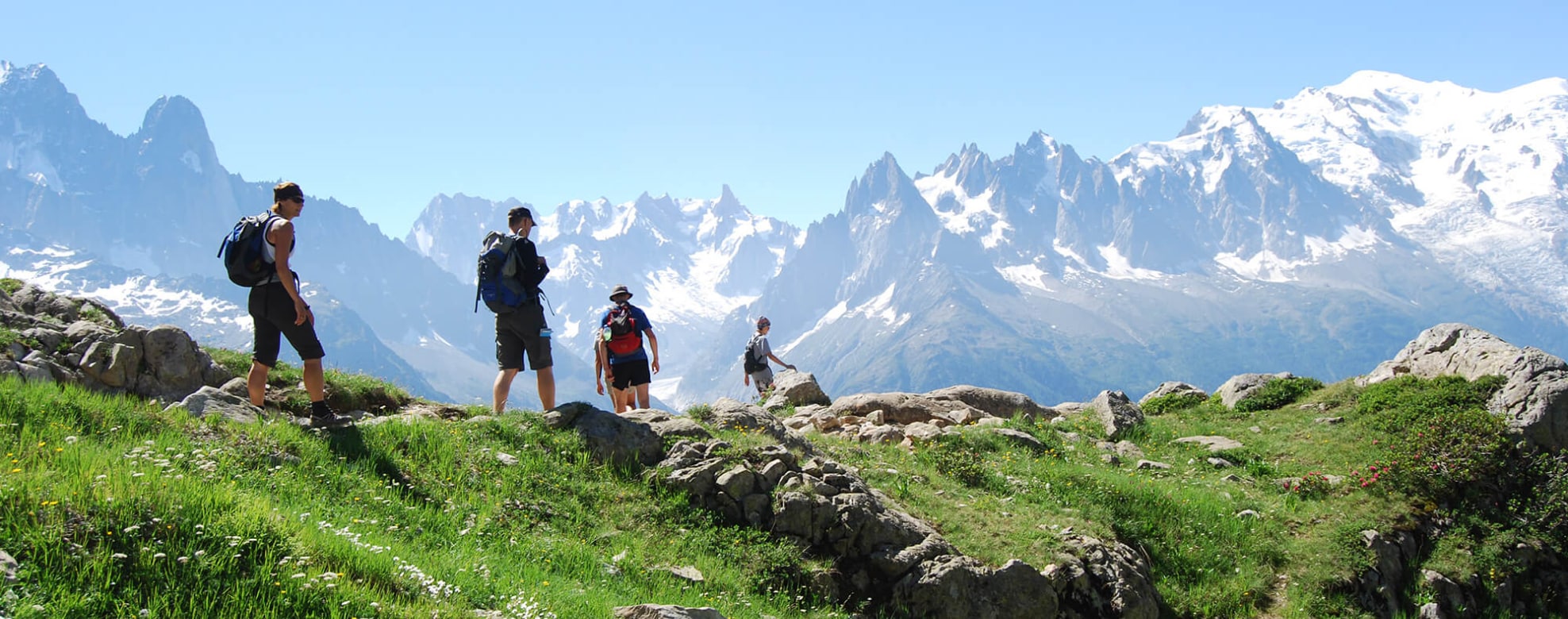
Austria and Liechtenstein are both renowned for their stunning alpine landscapes, rich cultural traditions, and warm hospitality. Trekking here offers a chance to immerse yourself in the natural beauty and unique character of these enchanting countries.
View All Points of InterestA Geographic Highlight on the Austria-Liechtenstein Trek At the Intersection of Nations: The Appeal of Naafkopf Naafkopf is a mountain peak located in the Rätikon range of the Alps, marking…
Learn moreA Tranquil Alpine Settlement in Liechtenstein A Hidden Gem in the Alps Nestled at an elevation of 1,300 metres in Liechtenstein’s Triesenberg municipality, Steg is a picturesque alpine village on…
Learn moreA Historic Settlement on the Austria-Liechtenstein Trek Discovering Warth’s Alpine Heritage Nestled at 1,500 metres in the Vorarlberg region of Austria, Warth is a small village with deep cultural and…
Learn moreWalser Valley: Cultural and Geographic Highlight Discovering the Walser Valley The Walser Valley, spanning Austria and Liechtenstein, is a geographic and cultural treasure. Known for its alpine beauty and historic…
Learn moreA Landmark Experience in the Rätikon Alps Discovering the Three Sisters and Alpspitz Panorama Trail The Three Sisters (Drei Schwestern) and the Alpspitz Panorama Trail are iconic highlights along the…
Learn moreReady to explore the world’s most stunning landscapes? Reserve your spot today!

Below are answers to some of the most common questions we receive about our Austria & Liechtenstein trek. If you have any other queries, please don't hesitate to ask. We want you to feel fully informed and confident before embarking on this alpine adventure.
The Austria & Liechtenstein trek is rated as 'Challenging' (Grade 3 of 5). This means you should be fit enough to comfortably hike for 6-8 hours per day, covering 10-21km (6-13 miles) with up to 1400m (4600ft) of elevation gain.
The terrain will vary from well-maintained trails to rough, rocky sections and some exposed parts where surefootedness is required. There are several long, steep ascents and descents, and you'll be hiking at altitudes up to 2570m (8430ft).
To prepare for this trip, we recommend engaging in regular aerobic exercise like hiking, cycling, running or swimming for at least 3-6 months prior to departure. The best training is to go on several long day hikes wearing the boots and pack you'll use on the trek.
If you have any doubts about your fitness level or have pre-existing medical conditions, please consult your doctor before booking. While challenging, this trek is within reach for most people with a good level of fitness and the right attitude.
Having the right gear is essential for your safety and enjoyment on the Austria & Liechtenstein trek. Here are the key items you'll need:
A full, detailed packing list will be provided upon booking. We're also happy to provide advice on gear selection and can recommend reliable brands and models based on our experience.
While it's important to come prepared, remember that you'll only be carrying a daypack with your daily essentials during the trek. Your main luggage will be transferred between accommodations (except for the 3 hut nights).
If you're missing any key items, there are outdoor gear shops in Zurich where you can pick up last-minute supplies. However, it's best to arrive fully equipped so you can focus on enjoying your trek from day one.
During the Austria & Liechtenstein trek, you'll experience a delightful mix of accommodations that showcase the best of alpine hospitality.
For 6 nights, you'll stay in comfortable, authentic 2-3 star hotels. These family-run establishments offer cozy rooms (usually with en-suite bathrooms), warm Alpine atmosphere, and delicious regional cuisine. Many have sunny terraces with stunning mountain views - perfect for post-hike relaxation.
One night is spent in a charming guesthouse, a converted 13th-century monastery in the tranquil village of St Gerold. Here, you'll find simple but comfortable rooms, a peaceful ambiance, and the chance to step back in time.
For 3 nights, you'll stay in well-equipped mountain huts (Göppinger Hütte, Gafadurahütte and Pfälzerhütte). These rustic refuges, located high in the Alps, offer dormitory-style accommodation, hearty meals, and unbeatable alpine vistas. While facilities are basic (shared bathrooms, no private rooms), the huts provide an authentic mountain experience and the chance to connect with fellow hikers.
All accommodations are carefully chosen for their character, cleanliness, friendly service, and ideal locations along the trekking route. They offer a comfortable and restorative base after each day's adventures.
Please note that single rooms are not available in the huts and are subject to availability in the hotels and guesthouse. If you're traveling solo, you'll be paired with a same-sex roommate. Couples may be accommodated in triple or quad rooms in the huts, depending on the layout.
While the accommodations may vary in style and amenities, they all reflect the warm hospitality and alpine charm that make trekking in Austria and Liechtenstein so special. Each offers a unique and memorable experience that complements the stunning natural surroundings.
Our Austria & Liechtenstein treks are limited to a maximum of 14 participants plus one certified International Mountain Leader. We believe this is the optimal size for a rewarding and intimate trekking experience.
With 14 people, the group is small enough to foster a sense of camaraderie and personal connection. You'll have plenty of opportunities to get to know your fellow trekkers, sharing stories and laughter along the trail and around the dinner table.
A smaller group also allows for greater flexibility and individualized attention from your guide. They can more easily tailor the pace, provide one-on-one support, and cater to the diverse interests and needs of each group member.
At the same time, 14 is large enough to create a dynamic group atmosphere. You'll have a variety of personalities, ages, and backgrounds represented, making for engaging conversations and diverse perspectives. Many of our participants form lifelong friendships on our treks.
From a practical standpoint, a group of 14 is well-suited to the accommodations and restaurants along the route. It ensures a personalised experience without overwhelming the small, family-run establishments we patronize.
In the unlikely event that fewer than 6 people sign up for a departure, we may need to cancel the trek. If this occurs, we'll notify you at least 4 weeks in advance and offer you the option to transfer to another departure or receive a full refund.
Trekking with a small group of like-minded adventurers is one of the joys of our Austria & Liechtenstein tour. It strikes the perfect balance between intimacy and energy, support and independence. We can't wait to share this unforgettable experience with you and your new trekking companions!
One of the great pleasures of trekking in Austria and Liechtenstein is the opportunity to savor the delicious local cuisine. The food here is hearty, filling, and full of flavor, designed to satisfy hungry hikers and showcase the best of alpine culinary traditions.
Breakfasts are substantial, setting you up for a day on the trail. In the hotels, expect a generous buffet spread with bread, rolls, cheeses, cold cuts, eggs, cereal, yogurt, fruit, coffee and tea. Mountain hut breakfasts are simpler but no less nourishing, usually featuring bread, butter, jam, cheese and hot drinks.
For lunch, you'll be provided with a packed picnic sourced from your accommodation. A typical lunchpack might include sandwiches, fruit, a chocolate bar or pastry, and a juice or soft drink. Many hikers supplement this with their own trail mix, energy bars, or other snacks.
Dinners are a celebratory affair, a time to relax, refuel, and relive the day's adventures. In the hotels and guesthouse, you'll enjoy multi-course meals showcasing regional specialties. Expect dishes like goulash (hearty beef or game stew), Käsespätzle (cheesy egg noodles), Tiroler Gröstl (a bacon, onion and potato fry-up), and of course, Wiener Schnitzel (breaded veal cutlet). Salads, soups, and scrumptious desserts like Apfelstrudel (apple strudel) round out the menu.
Mountain hut dinners are simpler but just as satisfying. You might be served a big pot of Gulaschsuppe (goulash soup), Hüttenmakkaroni (a cheesy pasta bake), or Kaiserschmarrn (fluffy, shredded pancakes dusted with sugar and served with applesauce). Hut cuisine is filling, no-frills fare designed to replenish calories after a long day of hiking.
Vegetarians will find good options on this trek, though choices may be more limited in the mountain huts. Most hotels and huts can also cater to common dietary restrictions like gluten-free or lactose-free with advance notice. Vegan options are available but may be quite basic, especially in the huts.
Drinks are not included with dinners but are available for purchase. Austria and Liechtenstein offer excellent local beers, wines, and spirits. Non-alcoholic options include water, soft drinks, juices, and hot beverages.
While the food is a highlight for many, the real magic happens around the table. Meals are a time to come together, share stories, and savor the sense of community that forms on the trail. The warmth and conviviality of Alpine dining is just as nourishing as the food itself. Guten Appetit!
Altitude sickness, also known as Acute Mountain Sickness (AMS), is a concern for many hikers in the Alps. It occurs when your body hasn't had time to adapt to the reduced air pressure and oxygen levels at higher elevations.
The good news is that the risk of altitude sickness on our Austria & Liechtenstein trek is relatively low. While you'll be hiking at elevations up to 2570m (8430ft), most of the trekking is done at lower altitudes, with only brief periods at the highest points.
Moreover, our itinerary is designed to allow for proper acclimatization. The daily ascents are gradual, giving your body time to adjust to the changing altitude. The rest day in Feldkirch (Day 6) also provides a valuable opportunity for recovery and adaptation midway through the trip.
That said, it's still important to be aware of the symptoms of altitude sickness and to alert your guide if you experience any of the following:
Most cases of altitude sickness are mild and can be treated with rest, hydration, and over-the-counter pain relievers. In rare cases, more severe symptoms may develop, requiring descent to a lower elevation and medical attention.
To minimise your risk of altitude sickness, we recommend the following:
Your guide is trained to recognise and respond to altitude sickness and will be monitoring the group closely throughout the trip. They may recommend changes to the itinerary if necessary to ensure everyone's safety and wellbeing.
With proper precautions and attention to your body's signals, most people can enjoy trekking at moderate altitudes without serious issues. The stunning alpine vistas and sense of accomplishment are well worth the effort!
Training for the Austria & Liechtenstein trek is essential for your safety, enjoyment, and success on the trail. The better prepared you are physically, the more you'll be able to focus on the stunning landscapes, camaraderie, and personal accomplishment of the experience.
We recommend starting your training at least 3-6 months before departure, depending on your current fitness level. A good training plan will build your cardiovascular endurance, leg strength, and mental stamina. It should also help you break in your hiking boots and get comfortable with your gear.
Here's a sample training progression:
Remember, everyone's fitness journey is different. The key is to start where you are and gradually build up. Consistency is more important than intensity. And don't forget to include rest days for recovery and injury prevention.
In addition to physical training, it's important to prepare mentally. Familiarise yourself with the itinerary, visualize yourself on the trail, and cultivate a positive, resilient attitude. Trekking can be challenging at times, but with the right mindset, you can overcome any obstacle.
If you have any pre-existing health conditions or concerns about your ability to train, please consult your doctor before beginning a new exercise regimen. They can provide personalised guidance and clearance for the trek.
Proper training will not only enhance your enjoyment of the trek but also contribute to the positive group dynamic. When everyone is well-prepared, the collective experience is elevated. You'll be able to encourage and support each other through the challenges and triumphs of the trail.
Remember, the Austria & Liechtenstein trek is a journey, not a race. Take your training one step at a time, celebrate your progress, and trust that you'll be ready when the big adventure begins. Your efforts will be rewarded tenfold in the beauty, accomplishment, and memories of your alpine experience.
Your safety is our top priority on any Salamander Adventures trip. While we do everything possible to prevent emergencies, we also have robust plans in place to respond effectively if an incident does occur.
All our guides are certified Wilderness First Responders (WFR) or hold equivalent certifications. They are trained to assess and stabilize a wide range of medical emergencies in remote settings. They also carry comprehensive first aid kits and are equipped with communication devices (cell phones and/or satellite phones) to coordinate rescues if needed.
In the event of an emergency on the trail, your guide will be your first point of contact. They will assess the situation, provide immediate care, and determine the best course of action. This may involve stabilizing the patient, calling for a helicopter evacuation, or organizing a carry-out to the nearest road or refuge.
Austria and Liechtenstein have excellent mountain rescue services, with a network of helicopters and trained professionals ready to respond to emergencies. In a life-threatening situation, a helicopter can often reach even the most remote locations within minutes.
For less urgent situations, your guide may arrange for a vehicle to meet the group at a trailhead or coordinate a pick-up from a mountain hut. They'll stay with the group throughout the process, ensuring everyone's safety and facilitating communication with rescue services, local authorities, and Salamander Adventures' office.
It's important to note that your guide's primary responsibility is to the safety of the entire group. They may need to make difficult decisions, such as ending a hike early or changing the itinerary, to prevent or respond to an emergency. Please trust and follow their instructions in these situations.
To help prevent emergencies, we ask that you:
In the unlikely event that you need to leave the trip early due to an emergency, your guide and our office staff will assist with arrangements and logistics. However, any additional costs (e.g. transportation, medical care, accommodation) will be your responsibility. This is where travel insurance becomes essential.
Your comprehensive travel insurance policy should cover emergency medical treatment, evacuation, and repatriation. It's your responsibility to understand your coverage and ensure it meets the requirements of the trip. We recommend purchasing a policy as soon as you book your trip and bringing your policy information with you on the trek.
While emergencies are rare, it's crucial to be prepared. With a skilled guide, robust emergency response plans, and appropriate travel insurance, you can trek with peace of mind, knowing that you're in good hands in any situation. Your well-being is our utmost concern, and we'll do everything in our power to keep you safe while ensuring an incredible alpine adventure.
Booking your Austria & Liechtenstein trek is easy and exciting! Here's a step-by-step guide:
If you have any questions or need assistance with the booking process, our knowledgeable and friendly office staff are here to help. You can reach us by phone, email, or through the contact form on our website.
We recommend booking early to secure your preferred departure date, especially for peak summer trips. Our small group trips do fill up quickly!
For added peace of mind, all of our trips are protected by ATOL (if they include air transport) or ABTOT (if they don't). This means your money is fully protected in the unlikely event of our insolvency.
Once you've booked, we'll be in touch regularly with updates, tips, and resources to help you prepare for your trip. We're here to support you every step of the way, from the moment you book until you return home with a heart full of alpine memories.
We can't wait to welcome you on this incredible journey through the Austrian and Liechtenstein Alps. Trust us, the hardest part is deciding to go - the rest is an unforgettable adventure!
To enter Austria and Liechtenstein, you will need a valid passport with at least 6 months validity remaining from your date of entry. For most nationalities, a visa is not required for stays up to 90 days.
However, entry requirements can vary depending on your nationality and any changes to international agreements. It's your responsibility to check the current visa and entry requirements for your specific situation.
We recommend checking with the Austrian and Liechtenstein embassies or consulates in your country of residence for the most up-to-date information. Useful resources include:
In addition to your passport, we recommend bringing a photocopy of your passport's information page and keeping it separate from your original document. It's also a good idea to bring a copy of your travel insurance policy and any important medical information.
If you're traveling from a country that is part of the Schengen Area, you can enter Austria and Liechtenstein with a valid national ID card. However, we still recommend bringing your passport as it's a more universally recognised form of identification.
While it's unlikely you'll need them, it's a good idea to have a few passport-sized photos with you, just in case you need to replace a lost or stolen passport during your travels.
As part of our pre-departure support, we'll send you a detailed packing list that includes all the necessary documents for your trip. We're also here to answer any questions you might have about visas, entry requirements, or travel logistics.
Ensuring you have the correct travel documents is a critical part of preparing for your trip. With a valid passport and the right information, you'll be ready to embark on your Austrian and Liechtenstein trekking adventure with confidence and ease.
Many of our trekkers choose to extend their stay in Austria or Liechtenstein before or after their trek. And for a good reason - these countries offer a wealth of cultural, historical, and outdoor experiences that are well worth exploring beyond the trail!
If you're interested in extending your trip, we're happy to assist with suggestions, bookings, and logistics. Our knowledgeable office staff can recommend activities, accommodations, and transportation options based on your interests and budget.
In Austria, popular pre- or post-trek destinations include:
In Liechtenstein, you might consider:
If you're planning to extend your stay, we recommend booking your accommodations and activities as early as possible, especially in peak summer season. We can assist with these arrangements or provide recommendations for booking on your own.
Keep in mind that any extended stay arrangements are subject to availability and are not included in the base price of your Austria & Liechtenstein trek. Any additional costs (accommodations, meals, activities, transportation) will be your responsibility.
Whether you choose to extend your stay or not, we're here to help make your entire Austrian and Liechtenstein experience as smooth, enjoyable, and memorable as possible. Just let us know how we can assist - we're always happy to share our local knowledge and passion for these incredible alpine destinations!
